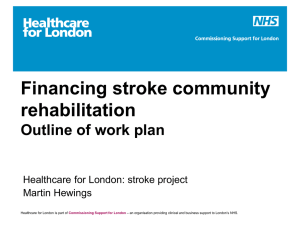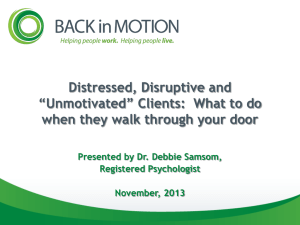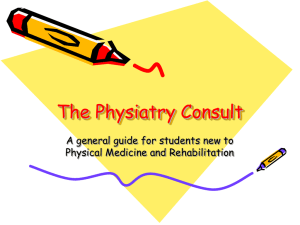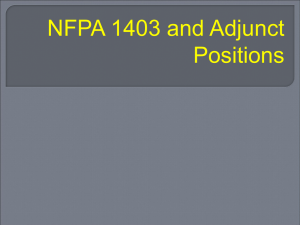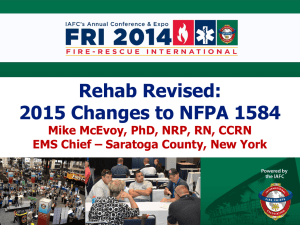Section 5 - Caring for Firefighters During Rehab Operations
advertisement
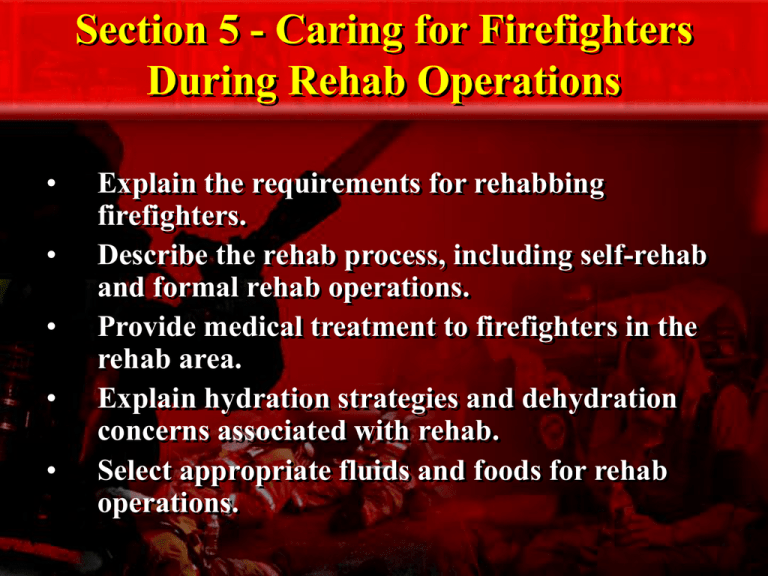
Section 5 - Caring for Firefighters During Rehab Operations • • • • • Explain the requirements for rehabbing firefighters. Describe the rehab process, including self-rehab and formal rehab operations. Provide medical treatment to firefighters in the rehab area. Explain hydration strategies and dehydration concerns associated with rehab. Select appropriate fluids and foods for rehab operations. Objective 5-1 Explain the requirements for rehabbing firefighters. NFPA 1584 Guidelines • Guideline #1: Self-rehab (with hydration) for at least 10 minutes following the depletion of one 30minute SCBA cylinder or after 20 minutes of intense work without wearing an SCBA. • Guideline #2: Must enter a formal rehab area, drink appropriate fluids, be medically evaluated, and rest for a minimum of 20 minutes after any of the following: – Depletion of two 30-minute SCBA cylinders – Depletion of one 45- or 60-minute SCBA cylinder – Following 40 minutes of intense work without an SCBA Objective 5-2 Describe the rehab process, including self-rehab and formal rehab operations. Self-Rehab Procedures • Usually done after expending one SCBA or short periods of heavy work. • Should be built into training ground evolutions. • Remove appropriate PPE • Drink at least 2-4 oz every 20 minutes; more in extreme conditions • Should rest for at least 10 minutes • Have other firefighters service SCBAs Number of Personnel Needed to Run the Rehab Area Depend On… • The number of personnel requiring rehab services • The duration of the incident • The environmental conditions at the time of the incident • Responder’s condition when they arrive at the rehab area. Entry Point/Initial Assessment Area • Everyone must go through this entry point and be logged in. • Shed SCBA and PPE, if appropriate • Check vital signs and be observed for other problems • May be sent to the Treatment Unit or Refreshment Unit, depending on their condition. Send to the Treatment Area if… • • • • • Pulse is in excess of 120 bpm Body temperature is in excess of 100.5ºF Diastolic blood pressure is above 90 mmHg Systolic blood pressure is above 130 mmHg Showing signs of chest pains, shortness of breath, altered level of consciousness, extreme fatigue, poor skin color, and similar symptoms. Rest/Refreshment Unit Responsibilities • Providing rest • Providing fluids • Providing nutrition Time Needed in Rehab • The responder’s level of physical conditioning • The atmospheric conditions • The nature of the activities the responder was performing before entering rehab • The time needed for adequate rehydration and/or eating • NFPA 1584 says 10 minutes after the initial assessment and 20 minutes if two SCBAs have been used or 40 minutes of heavy work performed The Three Dispositions for Responders Sent to The Treatment Area • The responder responds appropriately to rest and rehydration and is able to return to action or return to quarters. • Standard, basic EMS treatment procedures are initiated and the firefighter is monitored. • Advanced medical treatment, followed by transport to a medical facility. Transportation Unit Considerations • The number of transport units needed will depend on the size of the incident; one is the minimum • Personnel working the Treatment Unit should not also be responsible for transport • The Transportation Unit Leader should verify hospital status and capabilities. • If one ambulance transports, replace it with another standby unit. Reassignment Unit Dispositions • Reassign to another function on the emergency scene. • Return to service and return to the station or home, as the case may be. • Transport to a hospital for further evaluation and/or treatment. Options for Remaining Crew Members • Pair up with another group of firefighters. • Reassign to a function that can be handled with the remaining number of crew members. • Removed from service, particularly if their crewmate was seriously injured or killed. Objective 5-3 Provide medical treatment to firefighters in the rehab area. Rehab Area Injuries and Illnesses • Traumatic injuries • Thermal injuries • Stress-related illnesses • Respiratory illnesses Traumatic Injuries • These include cuts, sprains, strains, debris in eyes, etc. • Thoroughly clean and wrap cuts and small burns • Splint possible sprains or fractures and transport • Do not allow person to return to the incident if their injury could be made worse Stress-Related Illnesses • May be psychological and physiological • Decreased ability to mobilize the fight-or-flight response • Increases or decreases in the firefighter’s appetite • Suppression of the firefighter’s autoimmune system • An alteration in the perception of the severity of pain Signs of Overstressed Firefighters • Inappropriate levels of angry or aggressive behavior • Obvious emotional symptoms such as crying, yelling, or a sense of panic, often in an uncontrolled manner • Signs of being withdrawn, in a state of shock, or being depressed Two Types of Physiological Injuries • Heart Attacks • Strokes Classic Cardiac Symptoms • Shortness of breath, beyond that of someone who simply has been working hard and is tired. • Tightness in the chest or chest pain, often radiating to the back, abdomen, or down one or both arms. • Unusually rapid, slow, or otherwise irregular pulse and/or the sensation of heart palpitations. Common Signs of Stroke • • • • Severe headache Difficult, slurred, or lost speech ability Facial droop Weakness or paralysis on one side of the body, typically on the opposite side of the body from any present facial droop Lung Toxin Symptoms • May include a cough, breathlessness, wheezing, and excessive bronchial secretions. • Symptoms may start relatively soon after exposure to the smoke and continue to develop for up to 36 hours. • Adult respiratory distress syndrome or delayed pulmonary edema may occur in severe cases. Carbon Monoxide (CO) • CO is an asphyxiant. • Preexisting medical conditions increase susceptibility to CO poisoning, including hyperthyroidism, obesity, bronchitis, asthma, heart disease, and alcoholism. • Minor exposure symptoms include headache, nausea, vomiting, drowsiness, red/flushed skin appearance, and poor coordination. • Moderate or severe CO poisoning causes confusion, unconsciousness, chest pain, shortness of breath, and coma. Hydrogen Cyanide (HCN) • • • • Lighter than air and readily absorbed in the lungs Acts as a cellular asphyxiant. CNS signs and symptoms usually develop rapidly. Syptoms include excitement, eye irritation, headache, confusion, dizziness, nausea, vomiting, and weakness. • As poisoning progresses, drowsiness, tetanic spasm, lockjaw, convulsions, hallucinations, shortness of breath chest tightness, loss of consciousness, and coma may occur. • Easily confused with CO poisoning; difficult to diagnose in the field. Smoke Inhalation Treatment • Give high flow humidified oxygen. Intubate or ventilate if necessary. • Intubate immediately if there is stridor or respiratory distress, facial or neck burns, erythema, blistering or edema of the oropharynx. • If advanced life support personnel are available, start IV therapy according to local protocols. • Transport the victim to a medical facility as soon a possible. Objective 5-5 Explain hydration strategies and dehydration concerns associated with rehab. Hydration is the Key! • 60% of the human body is water • The human body loses water in urine, in stool, during exhalation, and through sweating. • During extreme work or exposure to high atmospheric temperatures, the majority of water lost from the body is from sweating. Individual Sweat Factors • The individual’s metabolism and physical fitness • The level of exertion • The atmospheric temperature • The amount of clothing and PPE being worn Electrolytes • Include sodium, potassium, calcium, and magnesium • Lost in the same way as water • Firefighters who are taking diuretic medications, such as Lasix®, will be especially susceptible excessive amounts of electrolyte loss. • Replace with sports drinks. Simple and Complex Carbohydrates • Simple carbohydrates: Sugars such as glucose, sucrose, dextrose, lactose, and fructose • Found in fruits, milk, processed sugar, and honey. • Complex carbohydrates: Molecules made up of three or more sugars. • Found in starchy foods, such as bread, pasta, and potatoes. • The body has a limited ability to store carbohydrates. • Medium to long duration incident will require carbo replacements. Prehydration • Drink at least 6-8 oz of fluids every 6 hours • Monitor urine output. • Avoid excessive amounts of caffeinated beverages. • Prior of (within 24 hours) causes dehydration. • Increase fluids if doing practical training exercises or physical training on duty. Redydration • Should drink 2-4 oz minimum during selfrehab • May drink 12 to 32 oz in formal rehab • Do not drink too much • Severely dehydrated personnel may require an IV • Must continue to rehydrate even after leaving the scene Objective 5-5 Select appropriate fluids and foods for rehab operations. Fluids for Rehab • Dispensed from individual or bulk storage containers. • Individual serving containers are best suited for small incidents; bulk containers for large incidents. • Drinking cups will be needed if using bulk containers. • Have trash receptacles available. Considerations for Choosing a Rehab Fluid • Must be tasty • Must be easily tolerable to the digestive system. • Should be nutritionally sound and replace electrolytes, carbohydrates and water. Suitable Drinks for Rehab Operations • Water is always good; does not replace electrolytes and carbohydrates. • Coffee, tea, soda, hot chocolate, dairy products, fruit juices, and high energy drinks (like Red Bull) are not good • Sport beverages replace water, electrolytes, and simple carbohydrates and are preferred. • Some agencies mix these 50/50 with water Food Service in Rehab • Usually only needed at incidents that exceed 2-3 hours. • May be needed sooner at late night/early morning incidents. • Short- to medium-duration incidents typically only require prepackaged foods. • Long-duration incidents may require meal-like support operations. Food Providers • Fire department canteen units • Independently operated canteen units (Red Crass, Salvation Army, etc.) • Brought to the scene by department members, church groups, or civic organizations • Commercial caterers Food for Rehab • Fast food that is better than nothing. • Seek a balance of carbohydrates, fats, and proteins • Fruits, doughnuts, candy bars, and energy bars are useful at short incident with no canteen. • Canteen units may serve hot dogs, hamburgers, egg sandwiches, cold cut sandwiches, soups, and stews. • Full service, long term caterers typically provide three full meal services per day at major incidents. Food Serving Principles • Wash your hands before eating. • All food serving equipment must be sanitary and fully compliant with local health department regulations. • All foods should be fresh and stored appropriately. • Have preestablished agreements with local grocery or food providers. • Provisions must be made for collecting and disposing of trash. • For medium and long term operations rotate out personnel and volunteers who are serving food.


